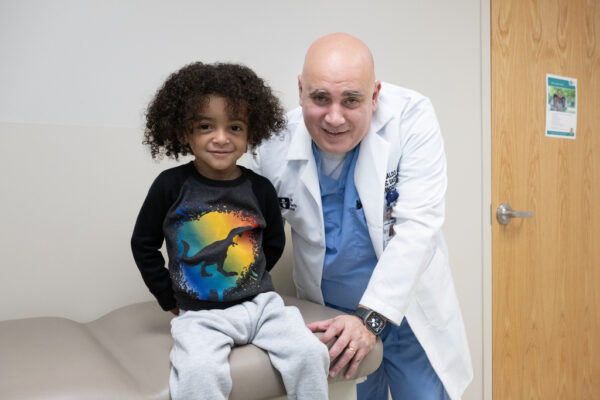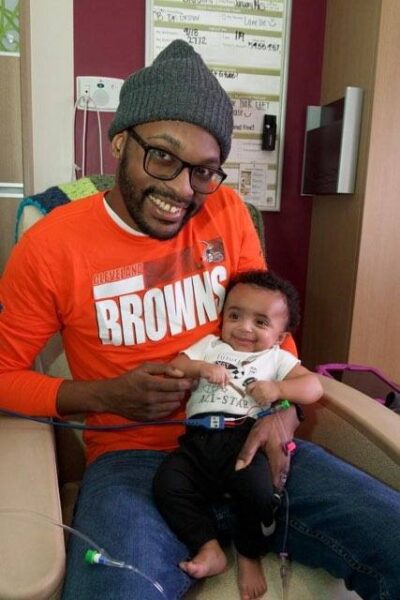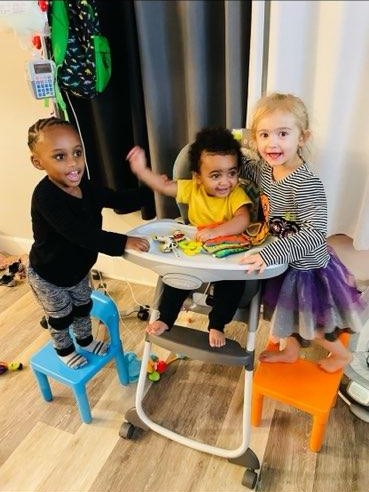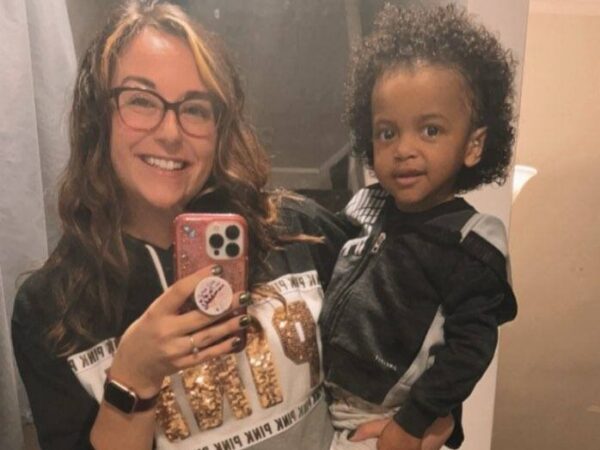
Bryson Proctor, age 3, sees Dr. Reinaldo Garcia-Naveiro, pediatric gastroenterologist and Pediatric Gastroenterology director, every other week to monitor Bryson’s care plan for short gut syndrome.
Facial expressions sometimes convey more than words ever can. At least, Tiffany Bailey of Akron, Ohio, feels that way.
In early 2020, Tiffany, who was 12 weeks pregnant with her second child, went to her prenatal appointment to get an ultrasound. Midway through the exam, the ultrasound technician made a face, excused herself and went to get the doctor.
“Instantly, I was worried,” Tiffany said.
When Tiffany’s obstetrician-gynecologist looked at the ultrasound, the doctor saw the baby had gastrochisis, a birth defect where the bowels grow outside the body. Gastrochisis requires surgery after birth to place the intestines back into the belly and close the opening. According to the Centers for Disease Control and Prevention, gastrochisis affects approximately one in 2,000 newborns.
Managing a high-risk pregnancy
Tiffany was referred to Akron Children’s Maternal Fetal Medicine Center where the Center’s specialists monitored her baby, a boy who she named Bryson Proctor.
At 35 weeks pregnant, Tiffany started having contractions. She was admitted to Summa Health System – Akron Campus where Akron Children’s operates a Neonatal Intensive Care Unit (NICU) and provides Maternal Fetal Medicine services.
“It was during COVID-19 and hospitals restricted who could visit,” she said. “We have other small children and Bryon’s dad, Tommy, stayed home with them until Bryson was born on September 18.”

Tommy Proctor holds his son, Bryson, who spent six months in Akron Children’s Neonatal Intensive Care Unit. Bryson has short gut syndrome that resulted from damage to his small intestines.
After his birth, Bryson was immediately placed in a special warming bag to protect his intestines and transported to the NICU. Before Bryson and his dad left, the clinicians brought the baby to Tiffany so she could see and touch him.
The next 10 days were hard on Bryson and his family. Nathan Heinzerling, MD, Akron Children’s pediatric general surgeon and trauma medical director, performed numerous surgeries to repair Bryson’s birth defect. However, part of his small intestines was damaged and had to be dissected, leaving him with 14 centimeters of intestines when they are normally 200 centimeters.
Bryson’s family feared he wouldn’t survive. After getting a reversible surgical procedure called an ostomy, which allows urine and stool to exit the body, Bryson finally started to improve.
Working with Akron Children’s Pediatric Gastroenterology team
Bryson remained in the NICU for six months during which time he had additional surgeries to reconnect his bowel, implant a central line for his nutritional needs and insert a gastrostomy tube, or G tube, into his belly.
“Once Bryson got the G tube, we started a whole new journey getting his feedings situated,” Tiffany said. “We had to figure out what and how much to feed him.”
After going home, Bryson had multiple doctors’ appointments each week, including weekly visits with Reinaldo Garcia-Naveiro, MD, Akron Children’s pediatric gastroenterologist and Pediatric Gastroenterology director.
“It was so hectic managing the number of hours needed to feed Bryson in that first month he came home,” Tiffany said. “When Dr. Garcia said we could cut down on the number of hours between feedings, it was like we won the lottery. It made such a difference.”
Now that Bryson is three, he sees Dr. Garcia once every other week.
“I like to see my patients frequently so we can make dynamic changes,” Dr. Garcia said. “Taking care of Bryson and patients like him requires a multidisciplinary approach. It’s not only about ensuring the child receives the calories, vitamins and nutrients they need. It’s also to ensure they have access to other resources, such as clinicians, social workers and/or nurses who can work with the families.”

Bryson enjoys playing with his siblings.
Making a lasting impact
The gastrointestinal (GI) program, which celebrated its 10th anniversary on October 1, 2023, is making a difference in Bryson’s family’s quality of life.
“The people in GI, I love them all,” said Tiffany. “What I like about working with Dr. Garcia is that he listens to me. He will always take my suggestions as he develops Bryson’s care plan.”
Right now, the plan is to wean Bryson off total parenteral nutrition (TPN), which is given intravenously through his central line and supplies the nutrients his body needs. Bryson has had numerous central line infections that led to multiple hospital stays. Additionally, he is active and crawls out of his crib, which has led to central line breaks.

Bryson Proctor’s mom, Tiffany Bailey, likes the responsiveness of Dr. Reinaldo Garcia-Naveiro and the Pediatric Gastroenterology staff. The Pediatric Gastroenterology program, which celebrated its 10th anniversary in October, 2023, is making a difference in Bryson’s family’s quality of life.
“If solids aren’t introduced by a certain age, the child develops a feeding aversion,” Dr. Garcia said. ”Bryson is in feeding therapy to treat that. It can feel as if we are engaging in a war with TPN so that Bryson begins to get nutrition through the gut. What’s important in this fight is how engaged the parents are. They are 90 percent of it when it comes to managing a child’s care and outcomes.”
Bryson’s family regularly sets goals for Bryson, who Tiffany has watched beat the odds time and time again.
“With any setback, I keep reminding myself, ‘This is temporary,’” Tiffany said. “I’m thankful that Children’s Pediatric Gastroenterology is here to help.”
Pediatric Gastroenterology celebrated its 10th anniversary on Oct. 1, 2023. The department has grown to include numerous in-patient services and out-patient clinics at multiple satellite offices throughout the state. Visit Pediatric Gastroenterology to learn more.










